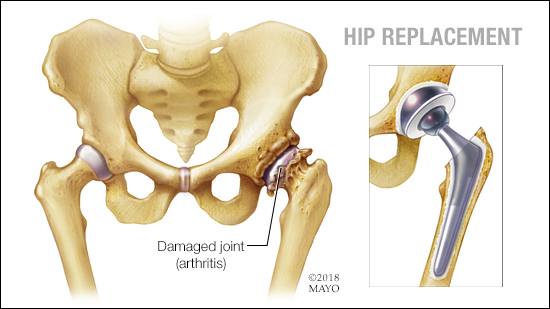-
Mayo Clinic Q and A: Uneven leg length after hip replacement surgery
 DEAR MAYO CLINIC: Is it normal for my legs to feel uneven after a hip replacement? I had a second hip replacement three months ago and feel like I need a shoe insert just to walk normally because of the difference, but my health care provider told me not to use one. Why would that be an issue?
DEAR MAYO CLINIC: Is it normal for my legs to feel uneven after a hip replacement? I had a second hip replacement three months ago and feel like I need a shoe insert just to walk normally because of the difference, but my health care provider told me not to use one. Why would that be an issue?
ANSWER: Equalizing leg length in people who have hip replacement surgery can be tricky. Various methods are used to restore equal leg lengths, but they don’t always work perfectly. While making leg lengths exactly equivalent after surgery is desirable, it is not always possible. And, in some cases, having slightly different leg lengths may be necessary to achieve the best result for long-term stability in the hip joint.
Hip replacement surgery, also called total hip arthroplasty, involves removing the hip joint and replacing it with an artificial joint that typically consists of metal, ceramic and hard plastic. For most people who undergo the surgery, hip replacement successfully relieves hip pain and restores hip function.
There are a few reasons why legs may not be equal in length after hip replacement. First, arthritis is one of the most common conditions that can damage hip joints and lead to hip replacement. As a result of the arthritic process, space within the joint is lost, and arthritis eventually can cause bone loss, as well. These changes may cause shortening of the leg affected by arthritis. When the joint is restored with hip replacement surgery, the leg is returned to the length it was before arthritis set in. That can result in the sensation of a longer leg after surgery.
Second, other medical conditions, such as scoliosis in the spine, can change a person’s body mechanics after hip joint replacement, and that may affect leg length.
Third, and possibly the most common reason leg lengths are unequal after hip surgery, is the need for stability within the replaced joint. As part of hip replacement, the soft tissues surrounding the joint must be stretched to the appropriate tightness to ensure that the joint stays in place. That can result in a slightly longer leg length. It is usually a matter of a few millimeters, and many people don’t notice it. But, in some cases, the difference may be more obvious.
Reconstructing the hip to ensure its stability is critical to successful hip replacement. It serves no purpose to have equal leg lengths if every time you sit down after surgery the joint dislocates because the soft tissues are too lax to hold it in place. In short, stability trumps exact equal leg length because a chronically unstable hip requires another surgery to correct the problem — a painful and expensive process.
The fix for a leg that is too long is a lift in the other shoe. There’s no medical reason not to use a shoe lift, and it can be an affordable and useful way to correct the disparity. If you feel more comfortable with a shoe lift in your shoe, use it.
If you notice other symptoms developing, such as ongoing discomfort or pain in the hip that was replaced, make an appointment to have that assessed as soon as possible, preferably with the surgeon who originally performed your hip replacement. Although leg length differences after hip replacement do not need additional treatment, the hip shouldn’t be painful. Pain after the surgery could signal an underlying problem that needs to be identified and treated promptly. — Dr. Richard Claridge, Orthopedic Surgery, Mayo Clinic, Phoenix







